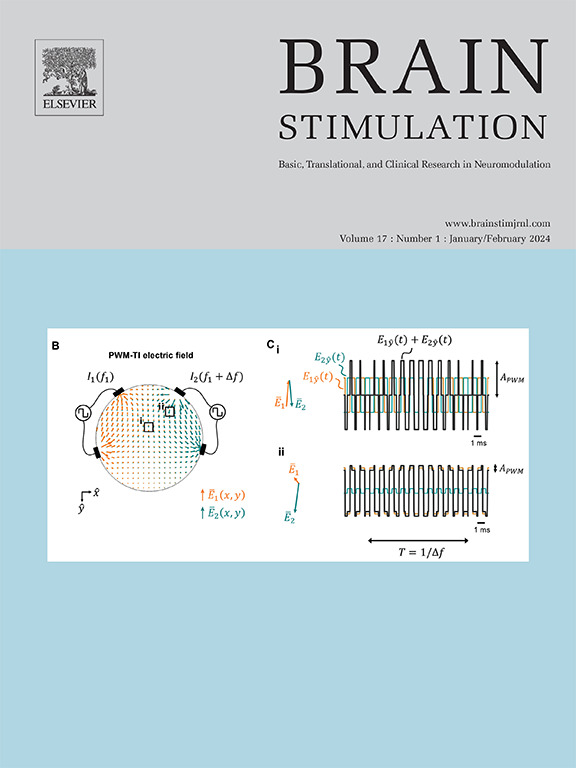经皮迷走神经刺激提高知觉决策的准确性
IF 7.6
1区 医学
Q1 CLINICAL NEUROLOGY
引用次数: 0
摘要
蓝斑-去甲肾上腺素(LC-NE)系统是一个公认的行为调节因子,但其确切作用尚不清楚。动物研究主要支持“增益”假说,表明LC-NE系统增强了感觉处理。相比之下,人类研究提出了另一种“紧迫性”假设,假设LC-NE主要加速反应。方法采用经皮迷走神经刺激(tVNS)进行两组实验。在第一个实验(n = 22)中,我们发现4-s tVNS训练与SHAM相比确实能诱导更大的瞳孔扩张,表明LC-NE活性增加。在第二个实验(n = 21)中,我们在随机点运动任务中应用tVNS来评估其对感知决策的影响。结果vns在不影响反应时间的情况下提高了反应准确率,这与“紧迫性”假说不一致。探索性漂移-扩散模型分析进一步支持“增益”假设,表明tVNS增加了漂移速率,表明证据积累增强。准确性和漂移率的改善在错误发生后最为显著,在SHAM下表现出错误后这些措施下降的参与者中尤为明显。我们的研究结果与“增益”假说一致,初步证据表明LC-NE活动的影响适应任务需求。因此,tVNS在容易导致准确性下降的情境中表现出最强的影响,这可能反映了注意力脱离,这表明LC在减轻注意力缺失方面的作用。本文章由计算机程序翻译,如有差异,请以英文原文为准。
Transcutaneous vagus nerve stimulation boosts accuracy during perceptual decision-making
Background
The locus coeruleus-norepinephrine (LC-NE) system is a well-established regulator of behavior, yet its precise role remains unclear. Animal studies predominantly support a “gain” hypothesis, suggesting that the LC-NE system enhances sensory processing. In contrast, human studies have proposed an alternative “urgency” hypothesis, postulating that LC-NE primarily accelerates responses.
Method
To address this discrepancy, we administered transcutaneous vagus nerve stimulation (tVNS) in two experiments. In the first experiment (n = 22), we showed that 4-s tVNS trains reliably induced greater pupil dilation compared to SHAM condition, indicating increased LC-NE activity. In the second experiment (n = 21), we applied tVNS during a random dot motion task to assess its impact on perceptual decision-making.
Result
tVNS improved accuracy without affecting reaction times, which appears inconsistent with the “urgency” hypothesis. Exploratory drift-diffusion model analyses further support the “gain” hypothesis, revealing that tVNS increased the drift rate, indicative of enhanced evidence accumulation. Both accuracy and drift-rate improvements were most prominent following errors and especially pronounced in participants who exhibited post-error declines in these measures under SHAM.
Conclusion
Our findings align with the “gain” hypothesis, with tentative evidence suggesting that the impact of LC-NE activity adapts to task demands. Accordingly, tVNS showed the strongest effects in contexts prone to accuracy declines, possibly reflecting attentional disengagement, which points to a role of LC in mitigating lapses of attention.
求助全文
通过发布文献求助,成功后即可免费获取论文全文。
去求助
来源期刊

Brain Stimulation
医学-临床神经学
CiteScore
13.10
自引率
9.10%
发文量
256
审稿时长
72 days
期刊介绍:
Brain Stimulation publishes on the entire field of brain stimulation, including noninvasive and invasive techniques and technologies that alter brain function through the use of electrical, magnetic, radiowave, or focally targeted pharmacologic stimulation.
Brain Stimulation aims to be the premier journal for publication of original research in the field of neuromodulation. The journal includes: a) Original articles; b) Short Communications; c) Invited and original reviews; d) Technology and methodological perspectives (reviews of new devices, description of new methods, etc.); and e) Letters to the Editor. Special issues of the journal will be considered based on scientific merit.
 求助内容:
求助内容: 应助结果提醒方式:
应助结果提醒方式:


